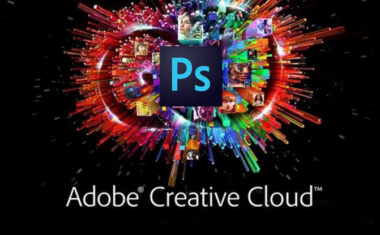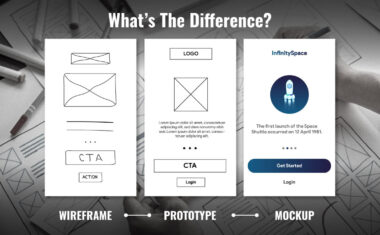11 Best UX Bootcamps to Boost Your Skills [2023 Guide]
![Best UX Bootcamps to Boost Your Skills [2022 Guide]](jpg/best-ux-bootcamps-to-boost-your-skills-2022-guide-2-scaled.jpg)
In this article
For the last 18 months, we have lived in a world where many digital 1wexperiences have no real-world alternatives at all. For instance, for most of 2020-22, you couldn’t meet your colleague in person and have a conversation. Zoom was the best you could do. While the world is opening up today, digital experiences have become omnipresent, opening up opportunities for professionals who design them—user experience (UX) designers.
UX design is among America’s top 25 best jobs, ranking higher among the most sought-after tech jobs. LinkedIn identifies it as among the most in-demand skills. It is also among the best-paid tech roles, with UX designers commanding top salaries in the range of $80,000-$100,000. Enterprises, small businesses, and startups alike are hiring UX designers today. However, there is an enormous talent gap. Few colleges offer graduate programs in UX design. On the other hand, as a practical field, self-learning on the job can be time-consuming and ineffective.
To quickly bridge the talent gap and offer practical training in user experience design, several UX bootcamps have come up. In this blog post, we identify the 11 best UX design bootcamps you can currently undertake. We also discuss how you can make the most of them.
What Is a UX Bootcamp?
A UX bootcamp is a short-term, immersive, hands-on training program in user experience design. Typically lasting from three months to a year, UX bootcamps offer foundational skills in UX design, supported by assignments and projects to practice those skills. Before the pandemic, they were offered both online and in-person. Most UX design bootcamps today are offered entirely online.
Best UX bootcamps prepare you for a career in UX design with:
- Strong theoretical foundation
- Small and large assignments, including capstone projects
- A portfolio that you can use in your job search
- 1:1 mentorship to ease your transition to a UX design career
- Career coaching to help you job strategy, interviews etc.
- Community of like-minded individuals for collaborative assignments and support
- Job guarantee
For specific guidance on choosing the best UX bootcamp for your needs, read the section titled ‘How Do You Choose a UX Bootcamp?’ below.
Best UX Bootcamps
Across free, paid, online, in-person, hybrid, and other varieties, there are dozens of UX bootcamps on offer today. However, not all of them are equal. Let’s look at them one by one.
| Company | Bootcamp/Course | Rank | Price | Details |
|---|---|---|---|---|
 |
UX Career Track | 4.66 | N/A | Learn More |
 |
UX Courses | 4.71 | N/A | Learn More |
 |
UX Design Program | 4.67 | N/A | Learn More |
 |
UX Design Course Online | 4.66 | N/A | Learn More |
 |
UX/UI Bootcamp | 4.66 | N/A | Learn More |
 |
UX/UI Bootcamp | 4.65 | N/A | Learn More |
 |
UX Academy | 4.55 | N/A | Learn More |
 |
Intro to User Experience Design | 4.5 | N/A | Learn More |
 |
UX Design Course | 4.48 | $9,900 | Learn More |
 |
Product Design UX/UI Bootcamp | 4.67 | N/A | Learn More |
 |
UX Design Immersive Online | 4.35 | N/A | Learn More |
Springboard
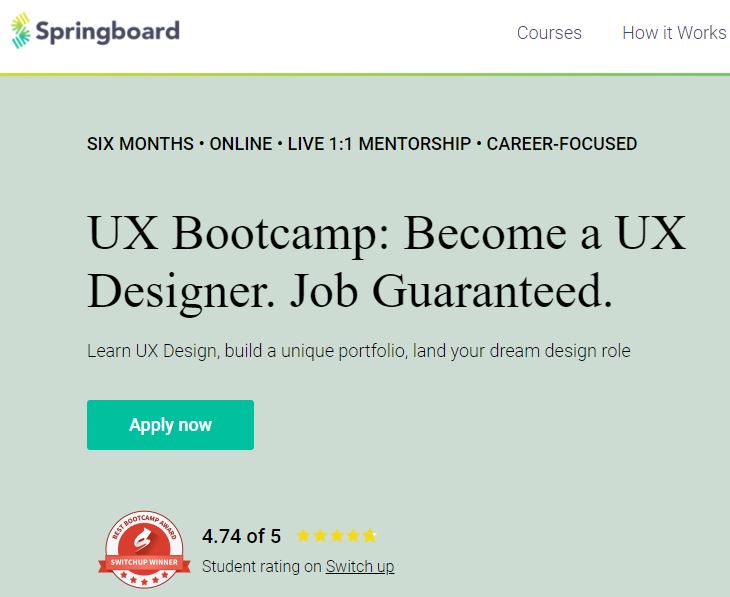
Rating
Overview
Springboard’s UX Bootcamp is a six-month training program offering 350+ hours of expert-curated curriculum, covering design thinking, user research, ideation, prototyping, wireframing, UI design, interaction design, and more.
As part of the program, you will complete several hands-on mini-projects and three portfolio projects. These projects will be of industry-standard giving you the experience of identifying a customer problem to solve, conducting competitive research, sketching, designing, building a prototype, performing usability, identifying improvements, and implementing them. You will be matched with a real company to complete a 40-hour industry design project.
This bootcamp also offers 1:1 mentorship with regular calls, career coaching, and a job guarantee.
Best For
As a part-time program expecting a commitment of 15-20 hours a week, the Springboard bootcamp is perfectly suited for students and professionals alike. However, it requires applicants to have at least one year of documented professional experience or a degree in user research, graphic/industrial design, architecture, etc.
Students who have no background can choose the 9-month UI/UX design bootcamp instead.
“I felt like I had a great support system because if I were doing it just on my own without a mentor… I don’t think I would have been as successful as I was.” — Heidi Sanders, Springboard Alumnus.
Interaction Design Foundation (IDF)
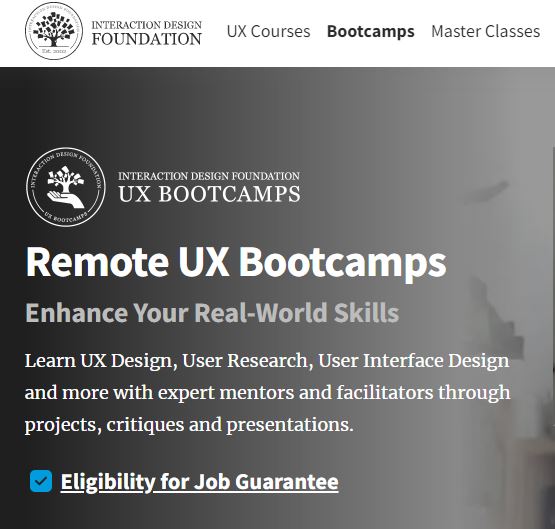
Rating
Overview
IDF offers four UX bootcamps to suit the needs of different kinds of professionals.
The first one, UX fundamentals, is for complete beginners looking to start or transition to a career in UX. It includes a combination of theory and practical assignments.
The second bootcamp is a specialization in user research. It is best for both beginners and experienced professionals. However, if you already have design experience, you can take on more complex projects.
The third one is a user interface-focussed bootcamp. This is also suitable for beginners with no design experience. However, if you’re a graphic designer or visual designer, you can take up advanced projects to demonstrate your skills.
The last bootcamp is an entirely practical program. This is aimed at those who already have some UX skills. This bootcamp helps you build a portfolio that can accelerate your job search
All of them are 12-week programs, needing you to invest 8-10 hours a week. It includes 1:1 mentorship and peer reviews. Each of these is a certificate program. When you complete three or more, you qualify for IDF’s job guarantee as well.
Best For
All IDF UX design bootcamps are suitable for beginners. If you already have skills in the field, you can leverage the community support, peer reviews, live practical workshops and mentorship to elevate your skills and experience.
CareerFoundry
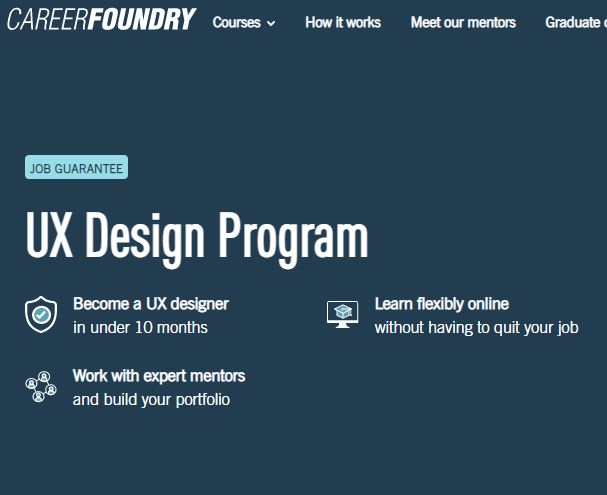
Rating
Overview
CareerFoundry’s UX Design Program is a fully online course that can be completed in 6 months, if you can spare 30-40 hours/week or in 10 months at 15-20 hours/week. This bootcamp focuses on the skills, tools, and processes you need to become a UX designer. You can also choose from UI design, voice user interface design, or front-end development as your specialization in the final module. It includes hands-on projects, mentorship, and career coaching.
Best For
This program does not have any prerequisites, making it suitable for students and professionals from any background.
Brainstation
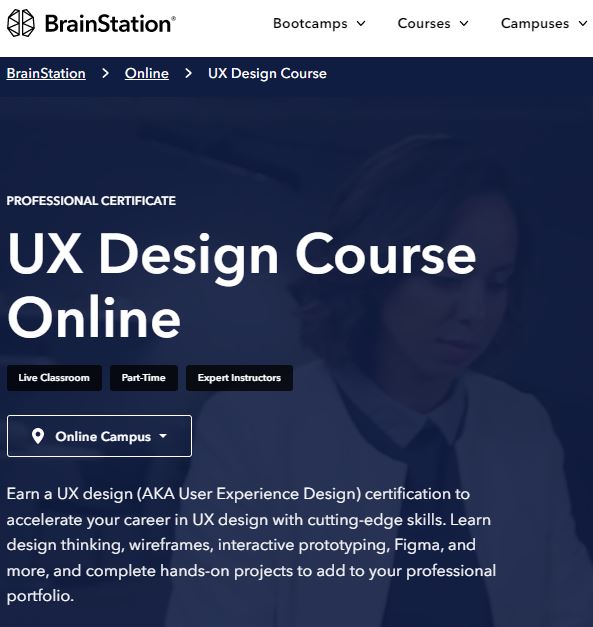
Rating
Overview
The BrainStation UX design bootcamp is available online and in-person across five global cities. The online program is made of real-time interactive classes and hands-on projects with your cohort in breakout rooms. The curriculum covers UX fundamentals, UX research strategy and planning, user interface design, applied design thinking, and UX as a career. You can choose to take the course part-time with classes on Tuesdays, Thursdays, and Saturdays or full-time with sessions Monday to Friday.
Best For
This program is best suited for those who prefer real-time interactive learning. It emulates the experience of a classroom online. However, if you’re looking for flexible self-paced learning, this might not work for you.
Thinkful
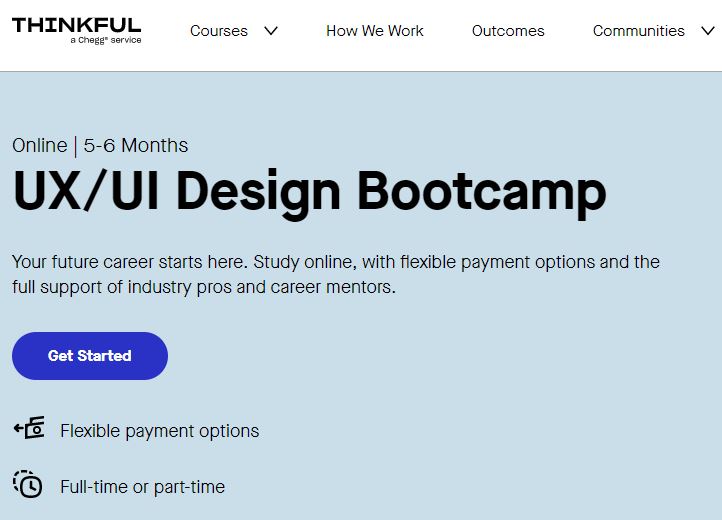
Rating
Overview
Thinkful’s UX/UI bootcamp is a flexible online UX/UI design program. Applicants can take it as a part-time course over six months, investing 15-20 hours a week or a scheduled full-time program with a cohort with 50 hours a week. It offers mentorships and career services as well.
Best For
The accelerated program is best for those who prefer a predetermined structure and deadlines to complete their work. If you’re unsure, you can also try out some beginner-friendly exercises on the platform to understand what you might expect.
Ironhack
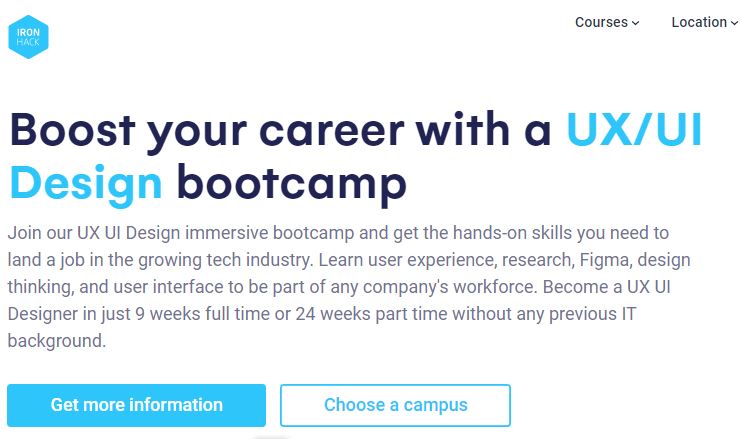
Rating
Overview
Ironhack’s 9 weeks full-time or 24 weeks part-time UX bootcamp offers an introduction to the field of user experience design. Broken down into four modules, it provides resources to learn the basics of web design, user experience, user interface design, and implementation. As a real-time interactive program, each day will include instructor-led sessions, breakout room projects, and 60 minutes of open office hours. It is also available in person in cities across the globe.
Best For
Ironhack says this program is best for career changers, entrepreneurs, career boosters, and web/mobile developers. While there is no prerequisite for joining the program, they recommend that it is best for those with some professional experience and solid social skills.
DesignLab
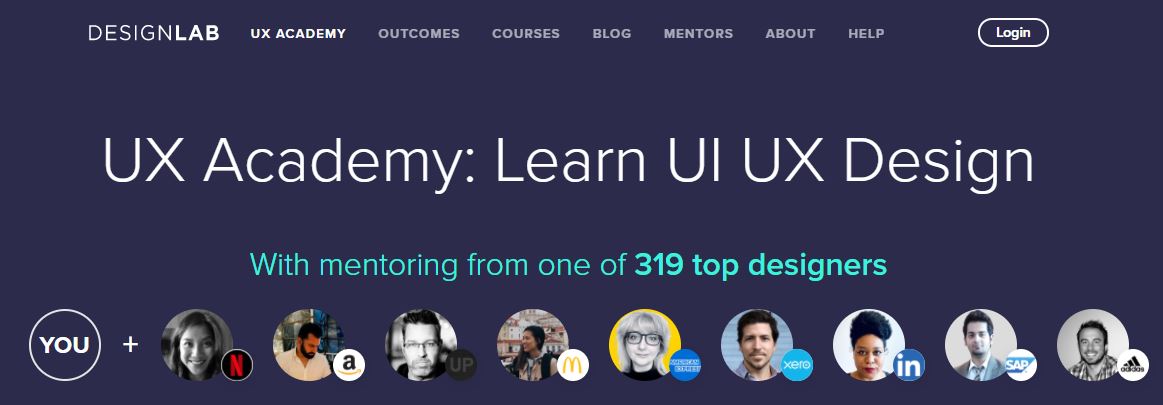
Rating
Overview
The DesignLab UX Academy is a community-driven UX bootcamp. In addition to 480 hours of coursework, 100+ hands-on exercises, four and four portfolio projects, this program also offers 12 group crits—group discussions to present your work and collect feedback—and ongoing support from a Slack community of UX professionals. You can complete this course in 28 weeks part-time or 15 weeks full-time.
Best For
This program is best for those who thrive in team projects and collaborative environments.
SuperHi
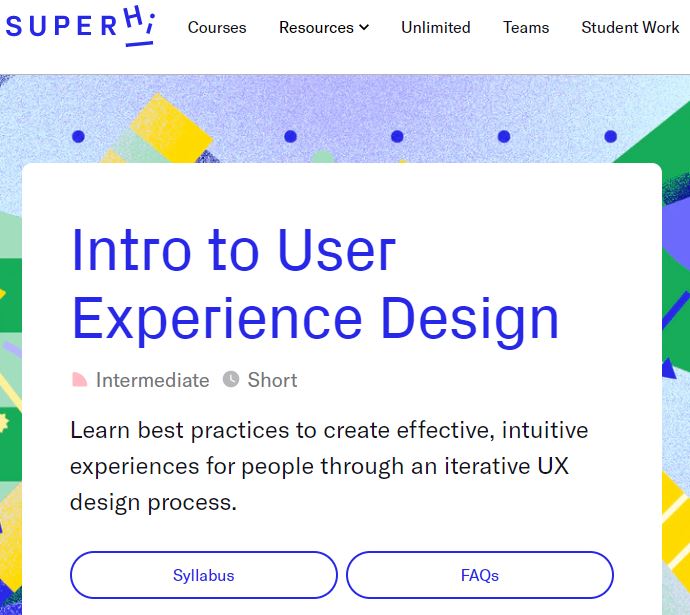
Rating
On Online course tutorials, SuperHI has a rating of 4.5.
Overview
Intro to User Experience Design from SuperHi is a short online course covering the basics of the field with topics such as user research, wireframing, prototyping, UI design, and user testing. It includes 5+ hours of video lessons, real-world projects, and support from the alumni network. As a beginner program, it does not have prerequisites. However, it helps to know the basics of MS Word, Photoshop, etc.
Best For
This is suitable for beginners as well as non-digital designers.
DevMountain
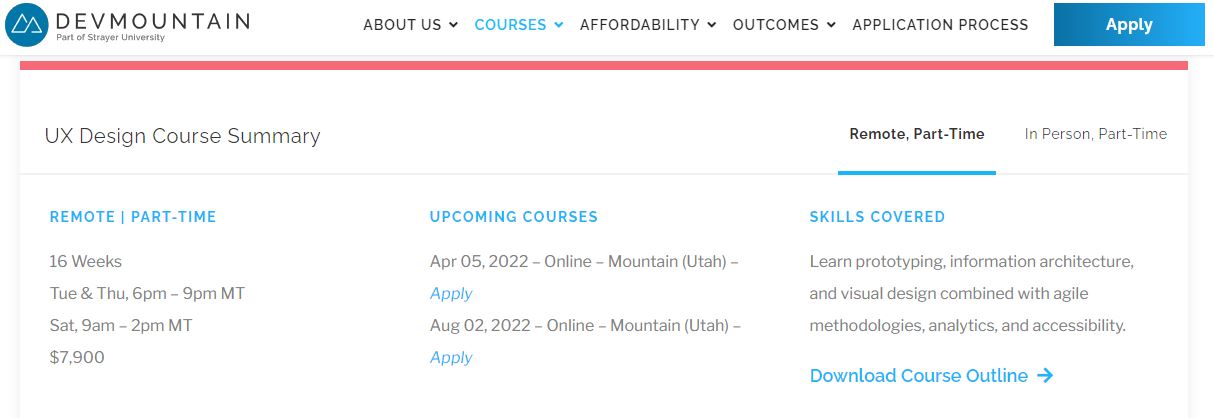
Rating
Overview
DevMountain’s UX design bootcamp is a 16-week course that prepares you for a career in UX design. This course focuses on teaching research, prototyping, information architecture, and how to design websites and applications.
Best For
This course is best for students or industry professionals who have a predetermined schedule. With classes meeting in the evening on Tuesdays and Thursdays and during the day on Saturdays, this course is not as flexible as others.
Flatiron
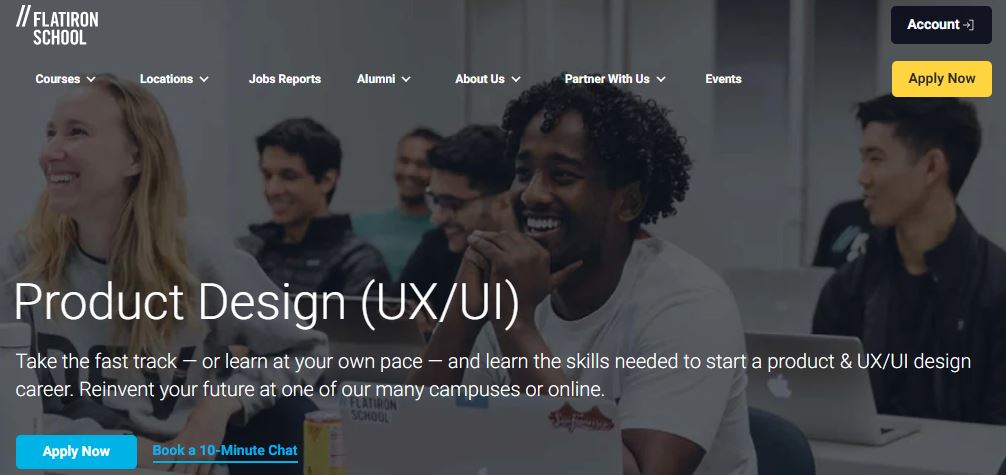
Rating
The Flatiron Product Design (UX/UI) Bootcamp is one of the most flexible programs available. You can take it up part-time, full-time, on-campus, or online. You can take up the course full-time with live lectures and complete it in 15 weeks. You can complete the same curriculum on a flexible schedule based on your situation in 20, 40, or 60 weeks. You can work independently while scheduling optional study groups or 1:1s with an instructor.
The curriculum includes modules in UX and UI processes, in addition to three modules of hands-on projects.
Best For
As a highly flexible program, this bootcamp is best for students and professionals alike. Depending on how soon you want to kickstart your UX design career, how much time you can spare, what mode of learning you prefer etc., you can choose the track that works for you.
General Assembly
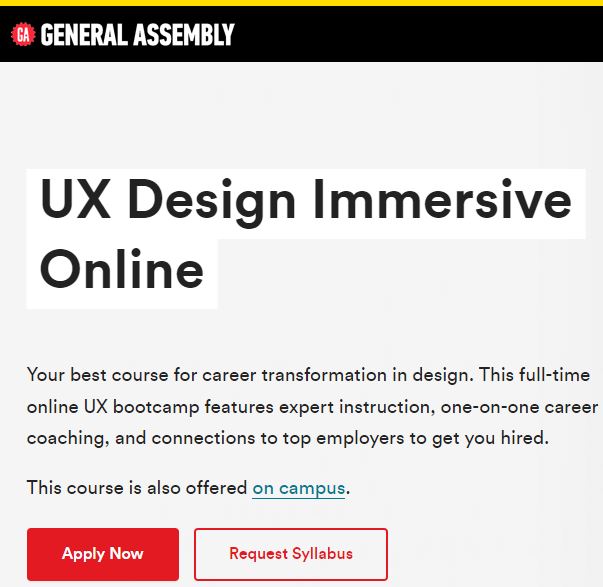
Rating
Overview
UX Design Immersive is designed to provide a well-rounded foundation in UX design. It offers classes in wireframing, prototyping, user research, usability testing, visual and user interface design, etc. It introduces the latest trends such as service design and design leadership. It also includes separate units for UX in the real world and career planning. General Assembly’s coaches will work with you to transition to your career in UX design.
Best For
This course is best for beginners looking to get started in UX design, gaining more than just technical knowledge but overall business and professional proficiency.
How Do You Choose a UX Bootcamp?

Not all bootcamps are the same. Each of them is designed keeping in mind the specific needs of their target audiences. For instance, if you’re already familiar with basic visual design techniques, some beginner-friendly courses might feel redundant to you. Some courses might expect upfront payment of fees, which you might not be able to afford. While many of them offer a job guarantee, the terms and conditions might vary.
Therefore, before choosing a UX bootcamp to invest in, it is important to make sure that it is right for you. Here are the key things you should evaluate your bootcamp on before you make a decision.
Curriculum
Whether you’re a beginner looking to learn just the basics or someone seeking foundational skills for a UX career, the curriculum is critical to achieving your goals. While evaluating a UX design bootcamp, check if it covers the entire spectrum of UX design skills, including design thinking, UX research, synthesis, ideation, wireframing, UI design, visual prototyping, and implementation. Look for the details covered in each module. Check whether it offers an in-depth understanding or simply the basics. Ensure that the curriculum also includes hands-on projects to apply the skills you’re learning.
Related Read: 11 Best Design Thinking Courses and Certifications
Instructors
To gain practical skills like UX design, it is critical to have instructors who have had some industry experience. In addition to instructors, also check if the program offers 1:1 mentorship with professionals. This will be critical in removing roadblocks from your UX design career journey and enabling a seamless transition into the professional world.
Cost
Each program is priced differently. Some charge a tuition fee, and some a monthly subscription. A UX bootcamp can cost anything from $2000 to $15,000. Many of them also offer scholarships and financial aid. Carefully evaluate the return on the investment you’re making. Check if the program provides a job guarantee or a moneyback program—this helps understand the confidence they have in the program they’re offering.
Job Support
To make a smooth transition to a UX design career, you need more than just skills and experience. You also need to write a resume, have a portfolio, write case studies, perform well in interviews and demonstrate your suitability for the job. A good UX bootcamp will also guide you through this process. Check if the bootcamp offers career coaching and how long after completing the course.
Reputation
There is no such thing as a hidden treasure when it comes to online courses. If it is a good program with a track record of success, it will have high ratings across various platforms. Look at websites like CareerReport, SwitchUp, CareerKarma, etc., for the ratings and reviews for the UX bootcamps of your choice. Choose the ones that are highly rated.
Get To Know Other Design Students
Nicky Arthur
UX Designer at International Baccalaureate
Jeffrey Surban
UX Designer at Citi
Parker Konz
Visual Designer at Gorilla Group
Making the Most Out of a UX Bootcamp
Once you’ve chosen which bootcamp you’d like to pursue, here’s how to make the most of it.
How Do UX Bootcamps Work?
Most UX bootcamps offer a combination of video/interactive lectures, small class projects, big capstone projects, and 1:1 mentorships. On a regular week, you’ll watch some lectures, apply your learnings to practical assignments and have calls with your mentor. To make the most of your experience at a UX bootcamp, understand what opportunities you have each week and leverage them as much as you can.
What Should You Expect To Learn During a UX Bootcamp?
The fundamental learning from any UX bootcamp would be the skills, both UX-related and behavioral skills. However, that is only the first step. As part of every bootcamp, you will have access to the UX community—professionals and fellow students. You should expect to learn to collaborate with diverse teams, build consensus, solve problems, etc. If you have a mentor, you should also expect to introspect and eliminate issues that might come your way.
What Will the Schedule Look Like?
Most UX bootcamps are offered part-time, expecting you to invest 10-20 hours per week for your learning. However, depending on the course you choose, your schedule might vary. Some of them might need you to dedicate specific hours, like Thursday/Saturday evenings. Some others might offer you the flexibility to learn at your own time.
FAQs About UX Bootcamps
Are UX Bootcamps Worth It?
A good bootcamp that offers comprehensive training, hands-on projects, industry design projects, 1:1 mentorship, career coaching, and a job guarantee will ensure a smooth transition to a UX design career. This will be worth the time and financial investment you make.
Are There Any Prerequisites for a UX Bootcamp?
This depends entirely on the bootcamp you choose. Some advanced programs might require you to have design experience. Some other programs like the Springboard UI/UX bootcamp do not require any prior experience.
Can You Become a UX Designer From a Bootcamp?
Indeed, many Springboard alumni have been employed in leading organizations like Facebook, Microsoft, Citi, LinkedIn, etc.
Since you’re here…
Are you a future UX designer? Enroll in our UI/UX Bootcamp and join over 10,000 students who have successfully changed careers with us. Want to get wireframing right this second? Check out our free UX learning path today.



